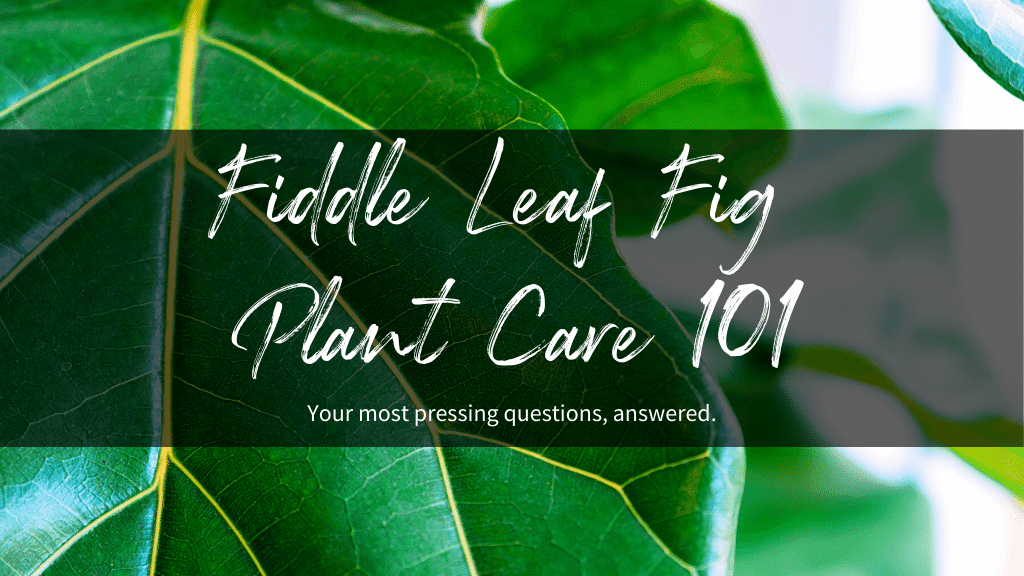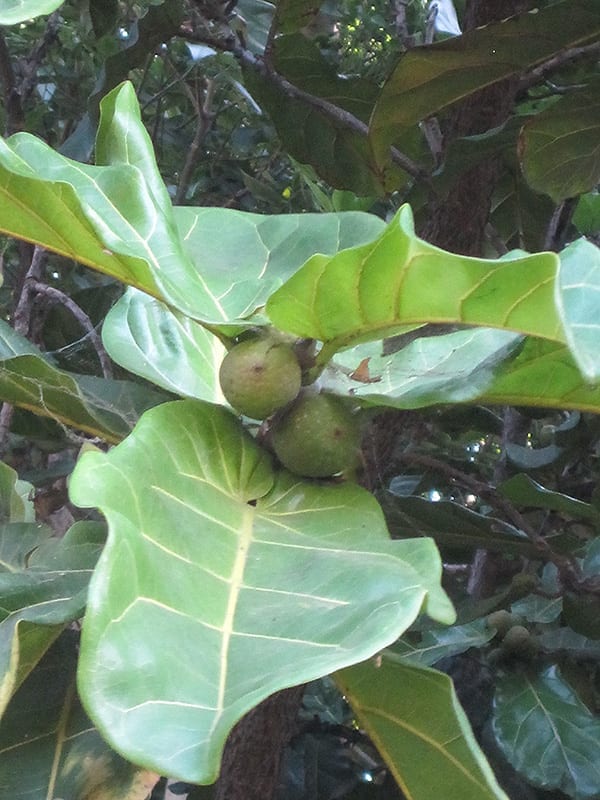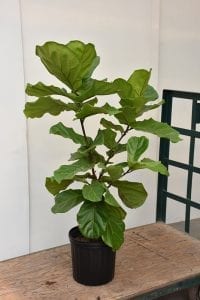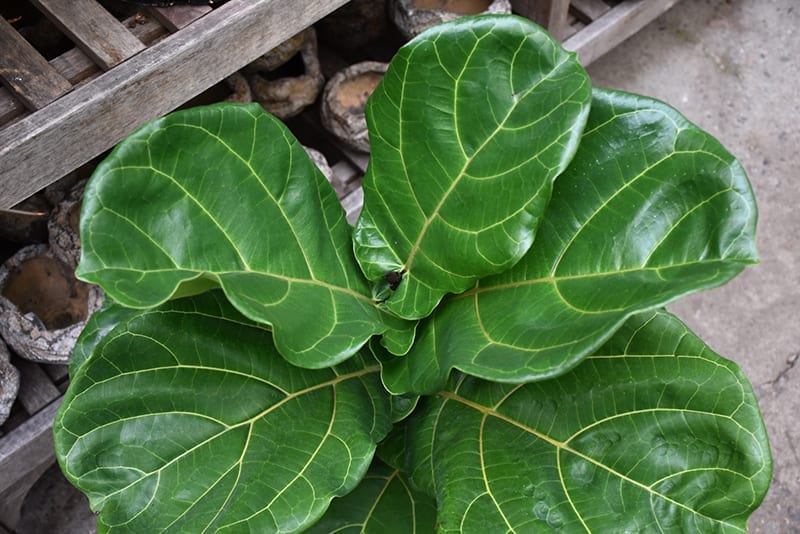It’s the go-to greenery on interior designers‘ “it” lists and graces the page of every home magazine or Instagram photo. It has design staying power and simply refuses to leaf (get it?). You may sometimes see its name shortened in modern articles to FLF or “Fiddle”. What plant is it? It’s the Fiddle Leaf Fig!
The Fiddle Leaf Fig makes an excellent specimen and floor plant. The leaves are unusually large and a pretty fiddle shape. (Thus, the plant’s name.) The bright green leaf color is a pleasing accent to a variety of decor styles.
Because we are trying to enjoy this striking plant in a dramatically different climate, some might have stereotyped it as ‘fussy.’ But, when grown indoors it’s actually pretty easy to grow. If we take time to imagine ourselves in its native habitat, then care becomes much more straightforward. So, yes…Midwestern houseplant lovers, you too can easily grow these beauties!
Also, these guys are homebodies. So, that means they don’t like to be continually moved to new spots in your house every week or month. When you purchase your plant and bring it home for the first time, remember that Fiddle Leaf Figs can be sensitive to changes in conditions like light or temperature. And your home’s conditions are likely to be different than the plant had during its stay in the greenhouse. But, heed these indoor plant care tips and you’ll have the happiest little Fiddle in town!
Where did the Fiddle Leaf Fig plant come from?
Even when growing indoors, a Fiddle Leaf Fig (Ficus lyrata) is surviving in far different conditions from its native environment. Fiddle Leaf Fig trees originate in the tropical rainforest of West Africa. These plants thrive below the forest canopy. So, their native environment is bright, but not sunny, and the air is warm and humid. Tropical conditions offer Fiddle Leaf Figs regular rain. If you’re able to mimic these conditions, then you’re likely to have success with this plant.
They are in the Moraceae horticultural family and are closely related to other ficus trees. Cousin species include the Banyan tree (Ficus benghalensis) and the rubber plant (Ficus elastica). Ficus pause their growth through the darker and cooler periods of the year (November to February). So, their largest period of growth occurs in the early spring (March to May).
How big does a Fiddle Leaf Fig grow?
When grown indoors and in our climate, a Fiddle Leaf Fig houseplant can reach 6 feet tall or more. Younger fiddle leaf figs can temporarily live on shelves while they’re small. As they grow, they are commonly seen as floor plants. Many conditions affect the ultimate height, spread, and performance of these indoor plants. A few of those factors include:
- the size of the pot it’s growing in
- the amount of light it receives
- watering frequency
- the pruning regimen and repotting schedule.
Does a Fiddle Leaf Fig create fruit?
Outside its native habitat, a fiddle leaf fig rarely flowers or fruits. But, we’ve included a photo of what the fruit looks like (right).
Most owners enjoy these houseplants for their foliage and stature, rather than their fruit-bearing capabilities.
How much water does my Fiddle Leaf Fig need? How often should I water it?
It’s important to talk about watering, drainage, and humidity in the same thought. As tropical plants, they appreciate a humid environment. If conditions are too dry, their leaves will fall off. This means you’ll always need to avoid placement directly in front of an air vent.
Though most Fiddle Leaf Figs are pretty resilient to indoor conditions and will adapt, you can help give your plant a boost by increasing the humidity levels. To do this, fill a saucer that is 1-2x larger than the pot with pebbles or small stones. Place the plant’s pot on top of the stones, keeping just enough water to cover the very bottom of the saucer. But, make sure there are enough stones so the pot isn’t sitting directly in water. (We should stress: do not fill the water to the top of the stones. The pot should not be touching the water in the saucer.) Or, place the humidity tray (stones and water) near the pot instead of placing the pot on top of it. The water will evaporate and increase the humidity for your Fiddle. Another humidity-trapping option is to place your Fiddle among other potted plants.
Don’t be fooled by thinking that wet soil and humidity are the same thing. They’re not. Your Fiddle Leaf Fig will do best in evenly and consistently moist conditions, but it will not tolerate soggy soil or standing water. Allow the top inch of soil to dry between waterings. (But don’t let it completely dry out so as to form a crust.)
Mike Davison, lead greenhouse buyer at Platt Hill Nursery recommends: “Give the plant a good drink. That means water the plant until its as heavy as the pot can get. Then, count how many days go by until it’s pretty light to lift, but not wilted. That’s how often you’ll water that particular plant until the environment changes. Recheck the watering days when you change your home environment. So, when you start running the heat or the air conditioning. Most issues I hear from my customers is from improper watering.”
Be aware that your particular watering schedule may be different depending on its location in the room, pot size, or plant size.
What are the Fiddle Leaf Fig’s light and temperature requirements?
Fiddle Leaf Figs must have a brightly lit environment. Its light requirements are often greater than artificial indoor lighting can provide. It’ll be happiest when it gets direct or indirect sunlight. (An East-facing window that gets gentle morning sun would be ideal.) If your Fiddle Leaf Fig is in front of large or single-pane windows, the plant can get easily sunburned. Sunburnt or scorched leaves can range in color, depending on how much exposure they’ve gotten. Leaf colors can appear white, yellow, light brown, or medium brown. Leaves may end up feeling crispy and may have a yellow ring around the edge of the brown spot.
It’s also best practice to rotate your plant a quarter turn with each watering. This helps ensure it’s getting even exposure to sunlight, especially if the plant is against a wall or in a corner of a room.
Do I need to think about a specialty potting soil or fertilizers?
If you’re planting or repotting, a well-draining soilless mix is best. There are great options from Miracle Grow or Espoma. We recommend contacting the experts at Platt Hill Nursery for with any questions.
Once planted, an all-purpose fertilizer (20-20-20) will work well. We recommend applying fertilizer only during the growing season. (March-October)
What kind of container is best for a Fiddle Leaf Fig?
A pot with good drainage is best. Some customers have seen success with a terra-cotta or ceramic pot. These materials are more porous and can offer more even soil moisture throughout the pot, making them great for novice Fiddle owners.
But, aside from the material, it’s important to think of the pot’s size. The goal is to provide a container that is only approximately 1-2 inches larger than its existing pot. If bringing the plant home during fall or winter, you might consider keeping it in its nursery container (sometimes called a “can”) until spring. A newly purchased Fiddle Leaf Fig is going to experience lots of change when it’s brought home. So, putting off repotting can avoid an additional change factor. If a nursery can isn’t fitting in with your decor, consider placing the nursery can inside your decorative pot. Just be sure to brace the nursery pot within the decorative one to avoid rocking or falling, as that can damage the leaves. It’s fairly easy to do this with small stones, but decorative vase fillers may be lighter-weight and can add style.
What other maintenance is recommended? Should I prune my plant?
Wipe the leaves with a damp cloth from time to time to remove dust. To do this with as little damage or leaf stress as possible, gently cradle the leaf in one hand. Then, wipe the top of the leaf with the damp cloth using your other hand. This will provide support to the part of the leaf connected to the branch or trunk while reducing the likelihood of bruising the leaf itself. Only dust the top side of the leaf, not the bottom side.
Though not required, pruning most ficus is best done in late winter, and the Fiddle Leaf Fig is no exception. Pruning encourages branching, which provides a fuller plant with more leaves. Pruning too late in the growing season or during winter may remove leaves that your plant needs. And, during darker winter months, it can use as much photosynthesis power as it can get! So, early February is often the best time to prune without sacrificing new growth that may appear in March. Spring is also a great time to consider repotting.
Fiddle Leaf Fig Plant Specs
- Botanical Name: FICUS LYRATA
- Horticultural Family: Moraceae
- Origins: West Africa, Tropical Jungle
- Foliage: Very large green leaves
- Height: 6 feet
- Spread: 4 feet
- Habit: Upright, as a tree. May be pruned as a shrub.
- Use:
- As a tree – floor houseplant
- As a mini – windowsill houseplant
- Toxicity: Possible stomach irritation in pets or people, if ingested
Platt Hill Nursery is Chicago’s premier garden center and nursery.




